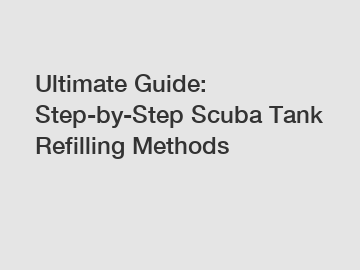Ultimate Guide: Step-by-Step Scuba Tank Refilling Methods
Ultimate Guide: Step-By-Step Scuba Tank Refilling Methods.
Scuba diving is an exhilarating and popular adventure sport that allows individuals to explore the wonders of the underwater world. A crucial aspect of scuba diving is ensuring that your dive tank is properly filled with compressed air or a gas mixture to enable safe and extended dives. In this ultimate guide, we will take you through step-by-step scuba tank refilling methods, ensuring you have the knowledge to enjoy a worry-free diving experience.
Step 1: Understanding the Basics.

Before delving into the refilling methods, it is essential to grasp the basics of scuba tank refilling. Scuba tanks are typically filled with compressed air or Nitrox, a gas mixture consisting of nitrogen and oxygen. Compressed air tanks can be filled at dive shops or using specialized equipment at home, while Nitrox tanks require specialized gas mixing at a certified facility.
Step 2: Choosing the Right Fill Station.
If you choose to fill your scuba tanks at home, you will need a fill station. The fill station consists of a compressor, filters, and other necessary equipment. Ensure that you select a reputable and reliable fill station that meets safety standards to ensure the quality and safety of the air you breathe underwater.
Step 3: Equipment Preparation.
Before refilling your scuba tank, it is imperative to inspect the tank's integrity and ensure it is within the designated hydrostatic test date. Additionally, check for any obvious signs of damage or wear. If everything checks out, it is time to prepare your equipment. Make sure the tank valve is closed and remove any dust caps present.
Step 4: Connect Tank to Fill Station.
With your tank prepared, it is time to connect it to the fill station securely. Ensure that all connections are tight, double-checking for any leaks. Safety should always be a priority, so ensure proper precautions are taken during this step.
Step 5: Safely Refill the Tank.
Once your tank is securely connected, it is time to start the filling process. Follow the manufacturer's instructions for your specific fill station carefully. Maintain a constant eye on the fill gauge to monitor the progress and avoid overfilling. The recommended pressure for most scuba tanks is around 3000 psi (pounds per square inch).
Step 6: Bleeding the Air.
After reaching the desired pressure, it is essential to bleed off any excess air or moisture present in the fill hose. This step helps prevent contamination and ensures the quality of air in the tank. Slowly open the bleed valve on the fill station and let the air escape until it is completely clear.
Step 7: Final Checks.
With the refilling process complete, it is time for the final checks. Inspect the tank for any signs of leakage, ensure all valves are closed, and properly reinstall any dust caps. It is crucial to examine the tank's pressure regularly to ensure it remains within the recommended limits.
Contact Us.
Scuba diving is a thrilling adventure that opens up a world of possibilities beneath the waves. By understanding the step-by-step scuba tank refilling methods, you can ensure the safety and reliability of your equipment. If you have any further questions or require assistance, please do not hesitate to contact us. Happy diving!
The company is the world’s best high pressure stirrup pump, china gx pcp compressor supplier, china gx e-5k2 pcp air compressor supplier supplier. We are your one-stop shop for all needs. Our staff are highly-specialized and will help you find the product you need.


